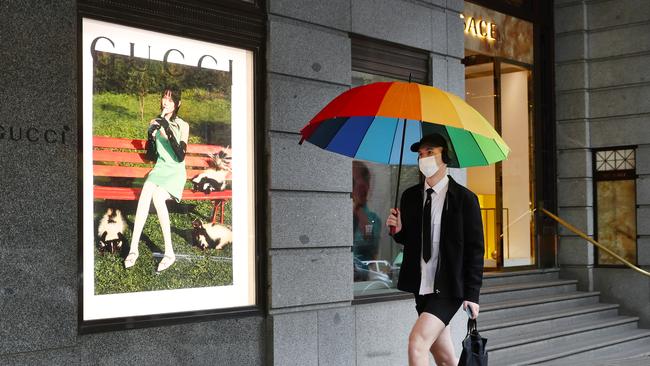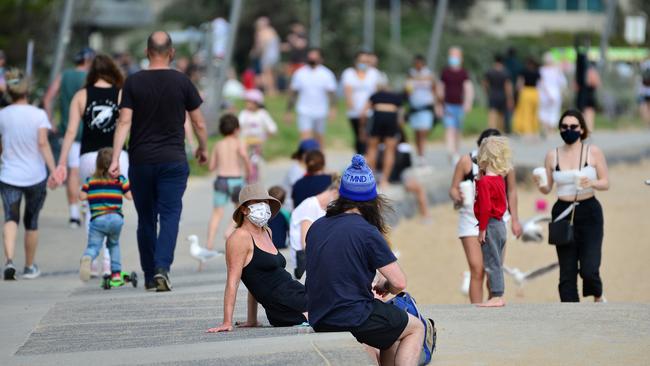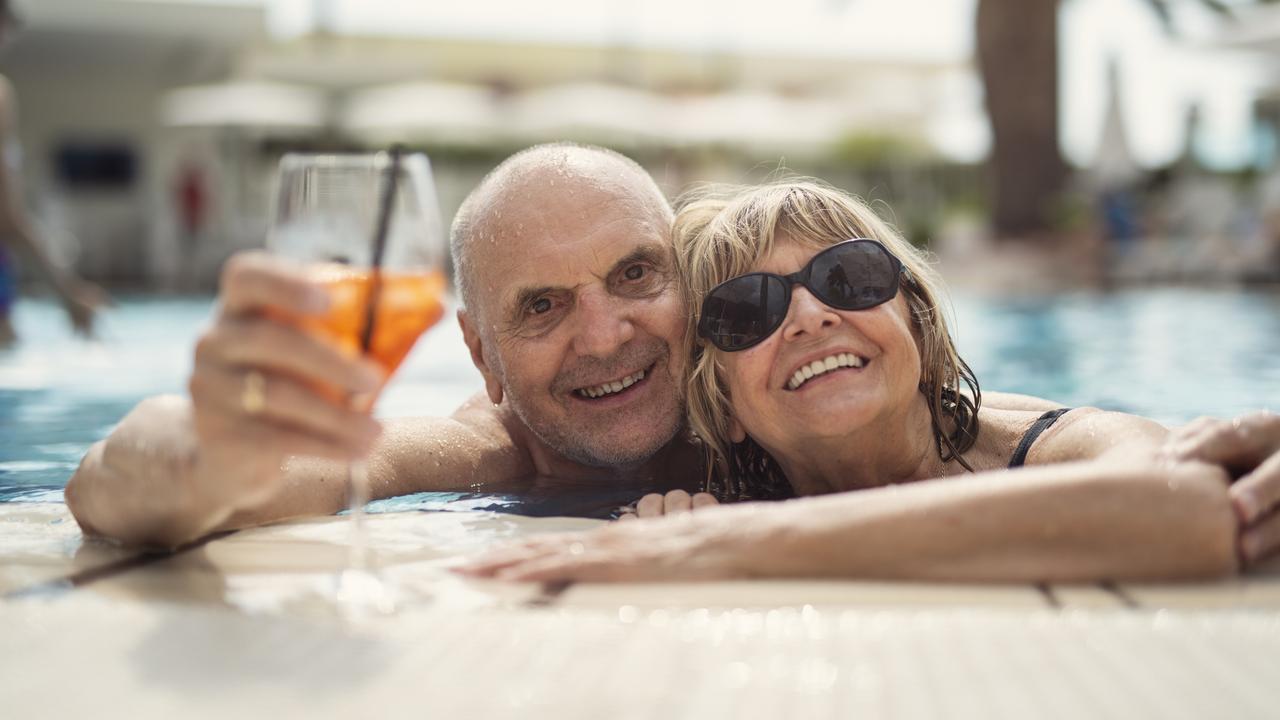Victoria records 15 new coronavirus cases, Premier hints at easing of restrictions
Melbourne’s 14-day rolling case average has dipped below 30 for the first time, as Premier Daniel Andrews hinted at the possibility more freedoms could be given when metropolitan areas move to step two. It comes as new high-risk coronavirus locations have been revealed.
News
Don't miss out on the headlines from News. Followed categories will be added to My News.
This coronavirus article is unlocked and free to read in the interest of community health and safety. Get full digital access to trusted news from the Herald Sun and Leader for just $1 a week for the first 12 weeks.
Daniel Andrews says he is considering easing restrictions beyond his planned roadmap with announcements to be made Sunday.
The Premier said an easing of restrictions could be fast tracked in certain areas, but said it was essential to continue on a steady and cautious path.
Mr Andrews said considerations would continue all week and would be based on modelling and data which was well ahead of predictions.
It comes as Victoria recorded 15 new coronavirus cases, along with five deaths overnight.
The state’s death toll is 771 and 20,100 cases have been recorded since the pandemic began.
And Melbourne’s 14-day rolling average has dipped below 30, now standing at 29.4.
The city’s 14-day average was 32.8 on Monday, well within the state’s 30 to 50 case range required to move to the second step on September 28.
Meanwhile, regional Victoria’s 14-day average is 1.1.
Ten of the state’s 15 new cases have been linked to known outbreaks, with five under investigation. Four of the 10 cases linked to outbreaks are in aged care.
Four are connected to the Alfred Hospital and Dandenong Police Station outbreaks, while two are linked to complex cases that remain under investigation.
There have been 609 deaths in aged care from coronavirus.
Active cases in the state have decreased by 66 since Tuesday.
The 554 active cases include 284 in aged care, 73 healthcare workers and 14 are in regional Victoria.
There are 75 Victorians in hospital, including eight receiving intensive care and six on a ventilator.
No new cases have been recorded in the Hallam cluster for the past three days. The cluster has reached 43 cases, with 19 of those still active.
Deputy Chief Health Officer Allen Cheng said Casey had four unknown source cases.
Mr Andrews said 15,000 people being tested for coronavirus in the past 24 hours was a strong number.
The state’s new cases are sprawled across several are, with three in Greater Dandeong; two cases in Manningham, Moreland and Wyndham; and singles cases in Boroondara, Frankston, Melton, Moonee Valley and Whittlesea. One case is still being investigated.


HIGH-RISK LOCATIONS
Three new sites have been added to the state’s high-risk coronavirus locations.
Anyone who visited the following locations is advised to watch for coronavirus symptoms and get tested immediately if symptoms occur;
PRIMARY MEDICAL and Dental Centre, 247-251 Station Road, Melton, between September 16 and 17.
WOOLWORTHS, COBURNS Central Shopping Centre, 523-531 High St, Melton, between September 16 and 17.
WOOLWORTHS CENTRAL Shopping Centre, Keilor Road, Niddrie, on September 18.
MODELLING BRINGS HOPE TO MELBURNIANS
Victoria’s daily coronavirus cases are predicted to be fewer than five as early as the middle of next week.
Independent modelling by University of South Australia Prof Adrian Esterman suggests if daily case numbers continue to fall, we may meet the October 26 threshold of five or fewer cases over a 14-day average in the next fortnight — or at the earliest by September 30.
Prof Esterman’s prediction is almost one month earlier than government modelling and what’s outlined in Premier Dan Andrews’ road map out of restrictions.
MELBURNIANS DON’T HAVE FREEDOM IN REGIONS
People travelling from metropolitan Melbourne to regional Victoria for work must adhere to stage four restrictions.
Mr Andrews said people from metropolitan Melbourne must follow the same rules they would if they were still in the city, despite being in the regions.
“For example, they can’t be going out to a restaurant for dinner … Although it won’t be exclusive, but in the main, this relates to people that live quite close to the metro-regional border and then work on the other side of that border,” he said.
“This was not so much an issue while their place of work was not open, but now that it is open, we think that this is a reasonable balance.”
Workers from Melbourne must have a valid permit to work in regional Victoria.
PACKAGE TO FURTHER SUPPORT MENTAL HEALTH
A $21.3 million package to help providers of mental health, alcohol and drug services reopen in a safe way has been announced.
Revealing the package on Wednesday, Mental Health Minister Martin Foley said the funding would help keep workers in a single setting where they need to have face-to-face services, while continuing telehealth services wherever possible.
“That involves extra funding for those services to pay workers more on their hourly and sessional rates to keep people at a single service, and to minimise the transfer of employees around different service providers,” he said.
“It also extends the opening hours of services so as to make sure that the demand of people who need those face-to-face services can be spread out over a longer period of time and minimise the chances of numbers of people congregating for those services.”
The funding will also deliver a series of minor works programs, including bed-based services, community alcohol and other support services, day programs, family and specialist care programs, Aboriginal community controlled organisations and complement the increasing use of digital health services.
Mr Foley said there had been increased levels of anxiety and depression among Victorians.
“And we’ve seen people who had previously been in the mental health system — the one in five of us who in any normal year, would seek support for mental illness and well being support,” he said.
NEED TO KEEP A LID ON NEW CASES
The easiest and hardest thing about this is this superspreading event phenomenon, Prof Cheng said.
“If we keep a lid on all the latest cases, it could actually fall fairly quickly but one case that happens to be in the wrong place before they become symptomatic, or in a situation where they can spread to a lot of people and it can be away very quickly,” he said.
Prof Cheng said Colac was an example that had been referred to many times.
“One case resulted in 30 additional cases,” he said.
“They’re the sorts of situations where we obviously get concerned about and we’re trying to prevent.”

HISTORICAL CASE CORRECTIONS
Only 15 new cases were recorded overnight, but there was an overall increase of 24 cases due to historical duplication corrections.
Prof Cheng said the 11 cases that were changed to confirmed were taken off the system inadvertently during the process of follow-up.
“Every time the lab makes a new diagnosis or a new positive test, they tell us and we go through our process to make sure that they are, in fact, an old patient that has been tested again, rather than a new case that needs follow-up,” he said.
“And they were followed up at the time.
“They date back to July and August mainly.”
Prof Cheng said as part of quality checking, they go back to check the record.
“But they were all followed up at the time. It was only in the process of taking them off from being an active case that they were removed,” he said.

WHEN LOCKDOWN WILL REALLY END
Victoria’s coronavirus case numbers are heading in the right direction with the crucial 14-day average in Melbourne dipping to 29.4 on Wednesday — down from 32.8 on Tuesday and 34.4 on Monday.
If that figure stays between 30 and 50 it will trigger the easing of some of the city’s restrictions on September 28.
That includes greater opportunities for socialising outdoors with up to five people from up to two separate households, and the reopening of childcare.
The rolling 14-day average is one of the key measurements which will determine the length of the city’s lockdown.
Read the full story here.
AGED CARE RESIDENTS MOVE BACK AFTER OUTBREAKS
Dozens of elderly Victorians removed from coronavirus-plagued nursing homes at the height of the second wave are beginning to return as the situation stabilises.
At least 45 elderly aged care residents are being moved back into 11 homes across Melbourne this month.
The Herald Sun understands St Basil’s in Fawker, where more than 200 people contracted the virus and dozens died, is among the centres welcoming back residents.
A spokesman for the Victorian Aged Care Response Centre said most residents were returning from hospital but some were also being moved from homes of their friends and family.
“This in an ongoing process which began in early September,” the spokesman said.
“These aged care facilities have had additional checks and infection control and prevention training to ensure they are safe for residents to return.”

Vulnerable elderly residents were moved as the virus took hold of facilities in July when it was deemed unsafe for them to remain.
A majority of the 766 Victorians who have died over the pandemic contracted the virus while in aged care homes.
Active aged care cases peaked at 2075 in mid August and have since fallen to 328 on Tuesday, with 24 new cases reported.
The Victorian government has unveiled a plan to upgrade public aged care facilities.
Up to 50 state-run homes will share in $30 million worth of facelifts after being tagged for upgrades in a 2019 report.
Changes will include building works, improved accessibility for staff and residents as well as installing new flooring, improving common areas and replacing ageing equipment.
Ageing and carers Minister Luke Donnellan said.
“From Avoca to Yarram, Broadmeadows to Ferntree Gully, this is an investment in our aged care facilities – but also the residents and families who rely on them.”
SCARY NEW IMPACT OF CATCHING COVID-19
Australian researchers are looking into whether being diagnosed with COVID-19 could increase a person’s risk of developing Parkinson’s later in life prompting a race to develop measures to beat the debilitating disease.
Scientists believe the virus is able to invade the brain and central nervous system, but they are yet to determine how.
Professor Kevin Barnham from the Florey Institute of Neuroscience and Mental Health in Melbourne said it was likely the virus could “cause insult to brain cells, with potential for neurodegeneration to follow on from there”.
Academics are now calling for the development of more diagnostic tools, such as a national screening program, which would help detect neurodegeneration early, as well as a long-term monitoring plan for people who have had COVID-19.

Neurological symptoms in people infected with the virus range from severe, such as a lack of oxygen to the brain, to mild, such as a loss of smell.
While the latter symptom may not cause concern, it can indicate something is happening beneath the surface, Florey Institute researcher Leah Beauchamp explained, such as acute inflammation in the olfactory system, which is responsible for smell.
Inflammation plays a major role in the development of neurodegenerative disease.
Loss of smell presented in about 90 per cent of people in the early stages of Parkinson’s – even a decade ahead – presenting a “new way forward” in detecting someone’s risk of developing the disease early, Ms Beauchamp said.
But the progression of the disease was quite slow and COVID-19 patients wouldn’t expect to see an onset of Parkinson’s until at least five years after being diagnosed with coronavirus, Prof Barnham explained.
He said similar neurological developments could unfold down the track.
Read the full story here.
NEW PUSH TO EXPAND NSW BORDER BUBBLE
Victoria is pushing for the state’s border bubble to be expanded to allow more areas to apply for travel permits.
Agricultural Minister Jaclyn Symes has written to the NSW government Minister Brad Hazzard requesting areas such as King Valley, Tawonga South, Ovens Valley, Buffalo River, and Greta to be included in the current travel exemptions, in the bid to help the local economies.
The current permit system allows residents within 50km of the border to travel between the two states.
However. Ms Symes said towns outside the catchment area that were COVID-free were suffering unnecessarily.
It comes as the idea of allowing all regional Victoria to be exempt from the border restrictions continues to be floated with New South Wales, however government insiders say the decision may be a long way off.
However, other states have begun relaxing their borders amid growing pressure to allow more interstate movement.
South Australian Premier Steven Marshall said the border will reopen to NSW from tonight.
Meanwhile Queensland will shift its current border zone, allowing residents from Byron, Ballina, Lismore, Richmond Valley, and Glen Innes access permits from October 1.
MORE NEWS
CORONAVIRUS: MELBOURNE AND VICTORIA’S ACTIVE CASES
GYM OWNERS CALL FOR NO-CONFIDENCE VOTE AGAINST GOVT
HOW VICTORIA’S ROADMAP COMPARES TO THE WORLD
Originally published as Victoria records 15 new coronavirus cases, Premier hints at easing of restrictions


